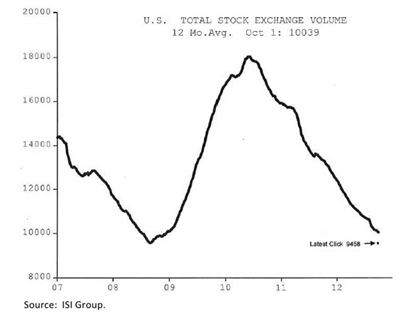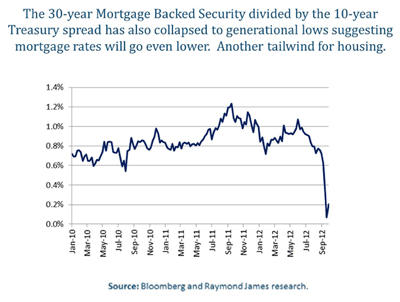“A Kid’s Market”
by Jeffrey Saut, Chief Investment Strategist, Raymond James
October 8, 2012
Last week a particularly wily Wall Street wag asked me, “Hey Jeff, do you know why everyone is underperforming the S&P 500?” “Not really,” I responded. He said, “Because the S&P has no fear!”
That exchange caused me to recall an excerpt from the book The Money Game. I like this story:
“My solution to the current market,” the Great Winfield said, “Kids. This is a kid’s market. This is Billy the Kid, Johnny the Kid, and Sheldon the Kid.” “Aren’t they cute?” the Great Winfield asked. “Aren’t they fuzzy? Look at them, like teddy bears. It’s their market. I have taken them on for the duration. I give them a little stake, they find the stocks, and we split the profits,” he said. “Billy the Kid here started with five thousand dollars and has run it up over half a million in the last six months.” “Wow!” I said. I asked Billy the Kid how he did it. “Computer leasing stocks, sir!” he said, like a cadet being quizzed by an upperclassman. “The need for computers is practically infinite,” said Billy the Kid. ”Leasing has proved the only way to sell them, and computer companies themselves do not have the capital. Therefore, earnings will be up 100% this year, will double next year, and will double again the year after that. The surface has barely been scratched. The rise has scarcely begun.”
“Look at the skepticism on the face of this dirty old man,” said the Great Winfield, pointing at me. “Look at him, framing questions about depreciation, about how fast these computers are written off. I know what he’s going to ask. He’s going to ask what makes a finance company worth fifty times earnings. Right?” “Right,” I admitted. Billy the Kid smiled tolerantly, well aware that the older generation has trouble figuring out the New Math, the New Economics, and the New Market. “You can’t make any money with questions like that,” said the Great Winfield. “They show you’re middle-aged, they show your generation. Show me a portfolio, I’ll tell you the generation.”
... “The Money Game” by Adam Smith
“The Money Game” was penned by an acquaintance of mine, namely Jerry Goodman, who took the nom de plume of legendary economist Adam Smith, author of the groundbreaking book “The Wealth of Nations,” first published in 1776. I met Jerry a few years ago at the offices of my friend Craig Drill, eponymous captain of Drill Capital, where another icon hangs his hat. That icon (Dr. Albert Wojnilower) is also from an era gone by when he, and his counterpart, rattled markets every time they spoke. Back in the 1970s and 1980s Al Wojnilower was affectionately referred to as “Dr. Gloom,” and his counterpart Dr. Henry Kaufman was deemed “Dr. Doom,” but I digress.
Expanding on the Great Winfield’s wisdom about a “kid’s market,” he goes on to say, “the strength of my kids is that they’re too young to remember anything bad, and they are making so much money they feel invincible.” He rented kids with the idea that one day the music will stop (it did partially in 1969-70, then completely stopped in 1973-74) and all of them will be broke but one. That one will be the Arthur Rock* of the new generation; Winfield will keep him.
I revisit “A Kid’s Market” this morning because of my opening “wily wag” quote and given the fact that most of the investors I talk to that are currently under-performing the S&P 500 (SPX/1460.93) are pretty young and thus have little fear of the downside. Indeed, with the SPX better by 16.17% YTD the bar has been set fairly high. Interestingly, while the SPX rallied 1.3% last week, the real winner was the recently maligned D-J Transportation Average (TRAN/5046.43) that rallied more than 3%. Recall that back in mid-May many pundits were chanting about the breakdown in the TRAN, below its March reaction low, and scared investors by not only suggesting a BIG decline was coming for the D-J Industrial Average (INDU/13620.15), but that a Dow Theory “sell signal” had been registered. At the time I argued against that view because according to the way I was taught Dow Theory the reaction “low” being used was not correct. To be sure, what subsequently happened was a downside non-confirmation, leading to a greater than 12% gain for the Industrials from that June 4th low, which brings us to this week.
Over the weekend many market mavens have been chanting about the yearly market leaders, like Apple (AAPL/$652.59/ Outperform), failing to rally with the overall stock market last week. While true, I don’t think such observations are a predecessor of a major stock market decline. Likely, the recent market strength was anticipating Friday’s better than expected employment report and trading types “sold” the good news. And despite partisan conspiracy-theorizing (like GE’s former CEO Jack Welsh who opined, “Unbelievable jobs numbers ... these Chicago guys will do anything ... can't debate, so change numbers”), Friday’s employment numbers were impressive. However, drilling down into those numbers shows that of the 873,000 people that found jobs, 600,000 had to settle for part-time work. Moreover, of the 114,000 jobs added last month, 110,000 were in what the Liscio Report termed, “The eat, drink and get sick” group, namely bars, restaurants, and healthcare. As Barron’s notes, “All, and then some of these revisions, came via the 101,000 jobs added in the local government education category. What the Liscio duo calls ‘excitable types’ [and] professes to see evidence of political manipulation.”
Manipulated, or not, while the cries of a “double top” in the SPX around 1475 are pervasive, I don’t believe them, just like I didn’t believe them a few months ago. As scribed in this report two months ago, when many sages were talking about a double top referencing the March/April 2012 highs at 1422 basis the SPX, I noted that the S&P 500 Total Return Index (and many other indices) was already trading to new all-time highs and was pointing the way higher. That’s still the case. Further, trading volume is abysmal (see chart on page 3), suggesting portfolio managers are still too defensively positioned. That gleaning is reinforced by an insufficient net-long position in the hedge fund community of only 46.5%, as well as a five-year high “short sale” position. Meanwhile, the money supply is surging, commodity prices are at the same level as five years ago (save gold), dividend increases in the SPX companies are at a record high (+20% y/y) despite those companies’ dividend payout ratios plumbing generational lows, a “put option” from the world’s central banks (read: liquidity), epoch low mortgage rates that are heading lower (see chart on page 3), rising home prices, well you get the idea.
To these points, increasing home prices, combined with better stock prices, are lifting consumers’ net worth and encouraging “fence sitters” to buy a house (University of Michigan “good time to buy a house” survey is at its highest level since 2004). That in turn is helping the banking system, which is why bank stocks are up about 26% YTD. While there are numerous Strong Buy-rated bank stocks, with yields, from our fundamental analysts, such as Huntington Bancshares (HBAN/$7.19), BB&T (BBT/$33.64), and Community Bank System (CBU/$28.41), I continue to think one of the best ways to invest in the banking complex is using the FBR Small Cap Financial Fund (FBRSX/$19.84) managed by David Ellison. I met David in the 1980s when he was managing Fidelity’s Select Financial Funds before associating with Friedman, Billings & Ramsey. David is my kind of investor because, like me, he considers “cash” to be an asset class. He demonstrated that when in the 1Q08 he raised 40% cash in his mutual funds, QED!
The call for this week: Third quarter earnings season kicks off this Thursday with Alcoa’s 3Q12 report. Plainly, for the rally to stay intact earnings cannot disappoint. And despite my sense that CEOs have stepped to the sideline on any spending until the November election and a resolution on the fiscal cliff, last week’s economic reports were good. Both PMIs were better than expected, vehicle sales jumped to 14.9 million units, refinance applications surged by 47%, and Friday’s employment report implies Industrial Production will probably look good on the next release. Therefore, despite this morning negative earnings story in The Wall Street Journal, I think the upcoming earnings reports will not disappoint. This morning, however, such worries, combined with Iran hostilities, the Syria/Turkey situation, a slowing economy, the presidential election, the fiscal cliff, and talk of a double-top in the SPX, are all coming together, leaving the pre-opening futures off 7 points. What the bears fail to realize, however, is that in the short-run there is not a linear relationship between the fundamentals and stock prices. Near-term support exists at 1450 – 1455. Major support resides at 1400 – 1422. With a full load of internal energy I think any pullback will be contained by one of those support zones.
*An American venture capitalist who was an early investor in companies like: Intel, Apple, Teledyne, etc.

Click here to enlarge

Click here to enlarge
Copyright © Raymond James











